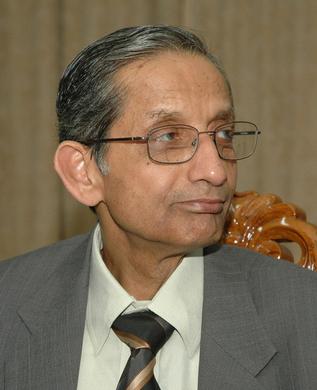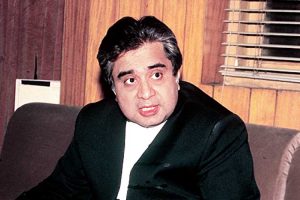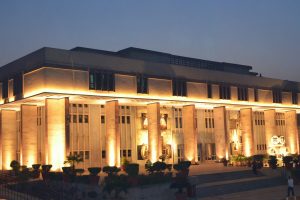“Any judicial system, even if it is perfectly structured, may yet not be an effective justice-delivery system if the persons working as judicial officers and administrative officers discharging judicial functions do not have the requisite operational skill or are not 1enthused to deliver robust substantial justice.”
Hon’ble Mr Justice S.B. Sinha
These were the words from Justice SB Sinha not only serve as a valuable piece of advice for those of us in charge of discharging judicial functions. They also provide us with the opportunity to have an idea of the sense of responsibility and sincerity which Justice Sinha had for his work, and the same is exemplified by the mammoth 2202 judgments he was part of during his tenure as an SC judge. But dedication for work was only one of many attributes of Justice Sinha’s outstanding personality as he was a man who was widely respected for his legal acumen, scholarly bent of mind, and his affable and humble persona.
EDUCATION
Justice S. B. Sinha was born on 8 August 1944 at Dhanbad in the state of Jharkhand, India. He passed his matriculation examination from H.E. School, Dhanbad and received his Bachelor of Laws (B.L) Degree from Chota Nagpur Law College in 1967. Justice Sinha commenced his distinguished legal career as an advocate in the Dhanbad District Court in the year 1968 and later transposed his practice to Ranchi in the year 1976, after the Permanent Bench of the Patna High Court had been constituted therein.
Owing to hard work, sincerity of purpose, sound knowledge of law and the legal acumen, he was soon designated as Senior Advocate by the Patna High Court, and subsequently elevated to the Bench of Patna High Court in 1987. Thereafter he was transferred to the Calcutta High Court in 1994, where he also served as the Acting Chief Justice. Thereafter, he was made Chief Justice of the High Courts of Andhra Pradesh and Delhi before being elevated as a Judge of the Supreme Court of India in 2002.
He was designated as Senior Advocate by the Patna High Court. Subsequently, he was appointed as the first Government Advocate of the Ranchi Bench of the Patna High Court and was elevated to the Bench of Patna High Court on 9 March 1987. He was transferred to the Calcutta High Court on 11 May 1994. He has served as the Chief Justice of the High Courts of Calcutta, Andhra Pradesh and Delhi.
He was elevated as a Judge of the Supreme Court of India on 3 October 2002 and retired on 8 August 2009.
On 3 November 2009, after retirement from the Supreme Court, Justice S. B. Sinha was appointed as the Chairman of the Telecom Disputes Settlement and Appellate Tribunal (TDSAT) succeeding Justice Arun Kumar who retired in September, 2009 and served for three years until the end of 2012.
PERSONALITY
Justice Satya Brata Sinha had an unparalleled capacity to work indefatigably, which endearingly earned him the fitting sobriquet ‘The Workaholic Judge’ from his colleagues and members of the Bar. Justice Sinha valued brevity in judgments. In an interview in 2011, he had stated that ‘the practice of writing long judgments should no longer be followed’. He had recommended following the practice in other countries, particularly the European courts, whose judgments, he felt, were ‘more precise than lengthy’. He proclaimed that ‘Brevity of judgment is the order of the day‘.
Justice Sinha had also voiced his concern regarding the accessibility of the higher judiciary to the poorer sections of the population. In an article on “Access to Justice and Judicial 3Reforms” he had written that “Access to Justice” is a curious phrase as it implies that the system of justice is not, in fact, available to all and that there are obstacles in the way.” He went on to say that: 3. Access to Justice and Judicial Reforms, Justice S.B. Sinha, Journal of the National Judicial Academy, 1 J Nat’l Jud.Acad. 2005, p.40. 10
“If access to justice is to be given to the citizens of India truly and effectively, justice must be given a new meaning and must be demonstrated with a different objective. Socio-economic right of the citizens should be at the forefront for giving access to justice to the needy, poor and deprived people.”
In the article, Justice Sinha provided important suggestions for changes in the judicial system, both at the structural and operational level, to ensure access to justice. His suggestions include discontinuing the practice of establishing Appellate Tribunals for he felt that the rationale for establishing appellate tribunals was no longer valid in view of the Supreme Court’s decision in L. Chandrakumar wherein it was held that jurisdiction of the High Court under Articles 226 and 227 is part of the basic structure and cannot be taken away by a constitutional amendment.
In his 2011 interview, referring to a survey which showed that only 9% of the people have approached a court of law, he had stressed on the need for judicial reform and disposal of old cases, to create ‘space’ for new cases.
In the 2011 interview, when he was asked about his future plans after completion of his tenure at TDSAT, he had said: “No future plans. I don’t plan my future as such”.
His retirement from the post of Chairman, TDSAT in 2012 did not permit Jus. Sinha to rest – he was a much sought after arbitrator who was engaged in several commercial matters, which permitted him to continue being the natural workaholic that he was!
Justice Sinha is amongst those legal luminaries who spoke in a redoubtable manner through their judgments. His irritation was evident when any party was not immediately prepared to handover case laws on any particular legal issue that came up for his consideration. For him, the development of jurisprudence on any point of law, right from the first judgment to the most recent case, was all tucked away; neatly filed in his memory and retrieving it, with the relevant page and paragraph number, could be done in a matter of seconds!
As a septuagenarian arbitrator, and much to the chagrin of his co-arbitrators, who probably had other engagements or were expected at home for dinner, Jus. Sinha was ready to permit the other party to commence arguments even as the clock ticked past 7:30 pm!
His judgements encapsulated the legal position on any point of law with remarkable clarity of thought. His decision in Santosh Bariyar v. State of Maharashtra, (2009) 6 SCC 498, is amongst the finest example of the same. In that case, Justice Sinha, modified a sentence for death penalty to rigorous imprisonment for life, and held that Ravji v. State of Maharashtra, (1996) 2 SCC 175, which held the legal precedent on death penalty in the country at the time, was faulty and needed to be reconsidered as it was contrary to the Bachan Singh principles. In holding so, he stated that “judicial principles for imposition of death penalty [in the country] are far from being uniform, [and also] that life imprisonment is the rule and death penalty an exception”. In line with his latter view on death penalty, Justice Sinha denied upholding the penalty in 17 cases (he decided in favour of acquittal of accused in 3 cases) which he heard on the issue while serving at the SC.
Justice Sinha is also amongst those judges of the Indian SC who are known for their instructive dissenting opinions. In 1994, Jus. Sinha was transferred to the Calcutta High Court, where he then served as Acting Chief Justice. He was also appointed as Chief Justice of the High Courts of Andhra Pradesh and then as Chief Justice of the Delhi High Court, before being elevated as Judge of the Supreme Court of India in 2002.
During his time at the Supreme Court, Jus. Sinha quickly became known for his dissenting judgments. In the case of Zee Telefilms Ltd. and Ors. v. Union of India and Ors. [(2005) 4 SCC 649], which was heard and decided by a Constitution Bench of 5 judges, Jus. Sinha delivered a bold dissenting judgment taking the view that the Board of Control for Cricket in India (BCCI) is a ‘State’ as it answers the description of “other authorities” as contained in Article 12 of the Constitution. Over 10 years later, in 2018, the Law Commission in its 275th Report has recommended that BCCI is to be viewed as an instrumentality of the State under Article 12, thereby making it amenable to the writ jurisdiction of the Courts and answerable under the RTI Act.
Justice Sinha’s judgments are insightful and have significantly contributed to the development of the law. In Santosh Kumar Bariyar and Ors.v. State of Maharashtra [(2009) 6 SCC 498], while again finding that it was not a case where the death penalty should be imposed, Jus Sinha noted that:
“Most research on this issue shows that the relationship between deterrence and severity of punishment is complicated. In the absence of any significant empirical attention to this question by Indian criminologists, we cannot assume that severity of punishment correlates to deterrence to an extent which justifies the restriction of the most fundamental human right through the imposition of the death penalty. The goal of crime reduction can be achieved by better police and prosecution service to the same or at least to a great extent than by the imposition of the death penalty.”
In that case, Justice Sinha referred to the various judicial pronouncements and observed that the principles for imposition of death penalty are far from being uniform. Therein lies the beauty of his judgments – Justice Sinha first mapped the interpretation of the law by various prior judgments before culling out the principles and applying them to the issue at hand. This approach was followed in each of his pronouncements.
Besides, he was also a firm supporter of the view that our justice delivery system needs to be improved for better results. In that regard, he vehemently argued for better utilization of human resources, transparency, judicial impact assessment, filling up of vacant judicial posts, use of information technology and ADR.
Jus. Sinha is survived by his wife, daughter, and two sons, who are both in the legal profession and have earned a name in their own right. Justice Sinha died on 19 March 2019 at the age of 74 after brief illness in New Delhi. His funeral was held on 20 March. Leading legal luminaries and his contemporaries condoled the death of a stalwart of India’s legal fraternity,
AUTHOR: Aditi P. who is Director of Public Relations & Business Development, Indian Law Watch













Add Comment